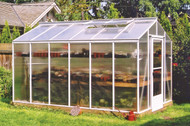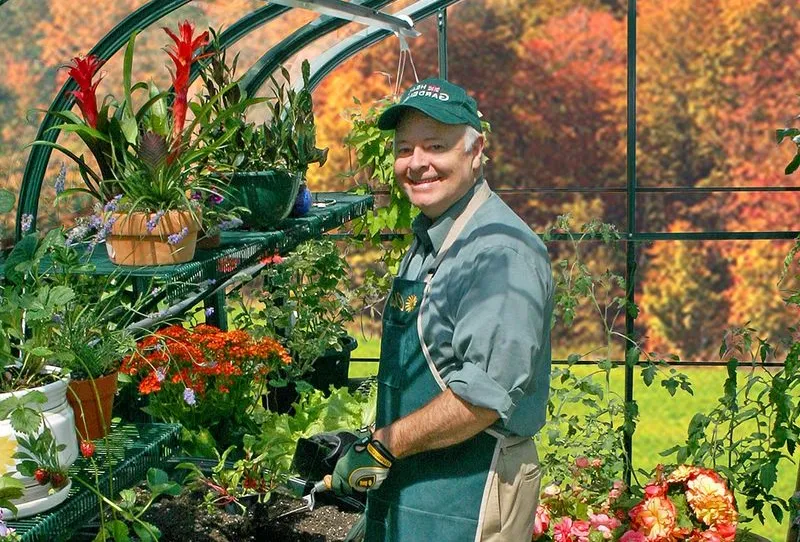Greenhouse Vent Positioning—Strategies, Tips, and Applications
Creating the perfect growing environment for your plants begins with proper greenhouse ventilation. The strategic placement and sizing of vents are crucial for controlling temperature, regulating humidity, and ensuring air circulation for your plants.
Explore greenhouse ventilation fundamentals and uncover tips to maximize your crop yields. From vents and fans to innovative automated systems, optimizing ventilation paves the way for an ideal climate in your greenhouse year-round.
The Importance of Proper Ventilation in Your Greenhouse
The right ventilation in your greenhouse creates the perfect growing conditions, offering four primary benefits: managing temperature, keeping humidity in check, ensuring good airflow, and keeping pests at bay.
Regulating Temperature
Greenhouses are excellent at capturing sunlight to keep plants warm, but they can get too hot without proper ventilation, even on cooler days. By strategically placing vents, you can let out excess heat, keeping the inside temperature just right for your plants.
For example, on a spring day when it’s 60°F outside, a greenhouse without good airflow could heat up to an uncomfortable 90°F by noon. This extreme heat can stress your plants, causing them to wilt, slow their growth, and not photosynthesize properly. Ventilation helps cool your greenhouse to avoid these problems.
Even in cooler weather, ventilation helps prevent too much heat from escaping at night, keeping the temperature steady throughout the year. Automated ventilation systems can adjust on their own, based on the weather, to ensure your greenhouse always has the ideal temperature.
Controlling Humidity Levels
In addition to heat management, proper ventilation keeps humidity levels in check, which is vital for healthy plants. Too much humidity can lead to fungal diseases and attract pests because they thrive in damp, still air.
You can avoid stale, moist air buildup by using intake and exhaust fans to keep the air moving. This is especially important when condensation is more likely to occur after watering your plants or after it rains.
Installing a ventilation system that kicks in automatically when humidity rises can keep the air inside your greenhouse fresh and prevent excess moisture. Maintaining optimal moisture levels creates a less hospitable environment for diseases and pests.
Ensuring Proper Airflow
In a greenhouse, stagnant air can prevent plants from exchanging gases and absorbing nutrients properly. This can also lead to areas where pests and diseases can thrive. An efficient greenhouse ventilation system keeps the air moving, making the inside of the greenhouse a healthier place for plants.
Using fans prevents pockets of still air and encourages uniform carbon dioxide (CO₂) distribution essential for photosynthesis. Oscillating fans can also mimic natural wind, helping strengthen plant stems by gently swaying them.
Proper greenhouse vent placement is also essential for improving pollination. Air movement helps to disperse pollen, increasing your crop yield. If your greenhouse cultivates fruit-bearing plants, ensuring that air circulation reaches all areas promotes successful pollination, leading to a better harvest.
Combating Pests and Gas Buildup
Proper ventilation creates an inhospitable environment for pests and deters infestations from common plant pests like spider mites, aphids, and whiteflies. Most garden pests prefer humid, stagnant conditions and cannot survive long in well-ventilated spaces.
Also, certain fertilizers, manures, and plant activities can release harmful gases such as ethylene, ammonia, and sulfur compounds. Good air circulation helps remove these gases before they can harm your plants.
Tips for Optimal Greenhouse Vent Positioning
Good ventilation promotes a healthy plant environment in your greenhouse. The following tips can help you place your vents in the perfect location—an often missed but essential step for keeping your greenhouse ecosystem balanced.
Use Roof and Side Vents for Optimal Temperature Control
Greenhouse roof vent placement and side wall vent positioning are key for keeping the temperature just right by making use of the natural flow of air. If you don’t let the hot air out, the temperature inside can soar, making it challenging for plants to grow.
Since hot air tends to rise, it can create warm spots at the top of your greenhouse. Placing roof vents at the highest points lets this hot air escape. Having vents on the sides, about halfway up the walls, lets cooler air in from outside, helping keep the temperature stable.
This combination of roof and side vents creates a steady flow of air that’s ideal for plant growth, keeping the temperature within an optimal range of 50-85°F, depending on the type of plants you’re growing.
On really hot days, position your greenhouse so the roof vents are in line with the direction of the wind to help push out even more hot air. And in cooler seasons, like fall and winter, you can adjust the side vents to ensure your greenhouse doesn’t get too chilly.

The Schaefer Greenhouse Vent System is designed specifically for the humid conditions of a greenhouse. Made with durable materials like aluminum, stainless steel, and PVC, it’s built to last. It features a variable-speed exhaust fan on a rustproof PVC shutter, keeping the environment inside just right for your plants.
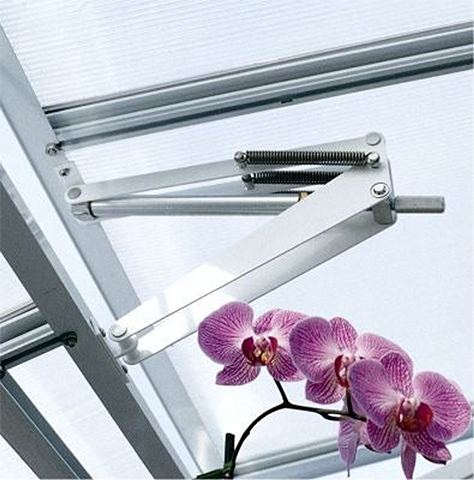
The Bayliss MK7 Orchid Solar Vent Opener for tropical greenhouses allows your greenhouse to become approximately 10°F warmer before opening the vent. With a triple-spring design, it works on wall or roof vents, providing efficient temperature control. This top-of-the-line solar vent opener operates without electricity, converting sunlight into mechanical energy.
Implement Automated Systems for Precise Ventilation Management
Technological advancements have enabled control of the environment inside a greenhouse using automated systems. These systems are equipped with interconnected sensors, programmable controllers, vents, and fans that work together to constantly check and adjust the conditions inside your greenhouse.
These systems measure temperature and humidity levels and compare them to what’s ideal for plant growth. If the interior gets too hot, for example, rising above 86°F, the system automatically opens more roof vents and turns on circulation fans to bring conditions back to optimal levels.
Operating around the clock, this precise control reduces the need to rely solely on natural airflow, ensuring stable temperatures and humidity even during extreme weather. Though the upfront cost of an automated system might be higher, the savings in labor over time and the improvements in disease prevention make it a worthwhile investment.
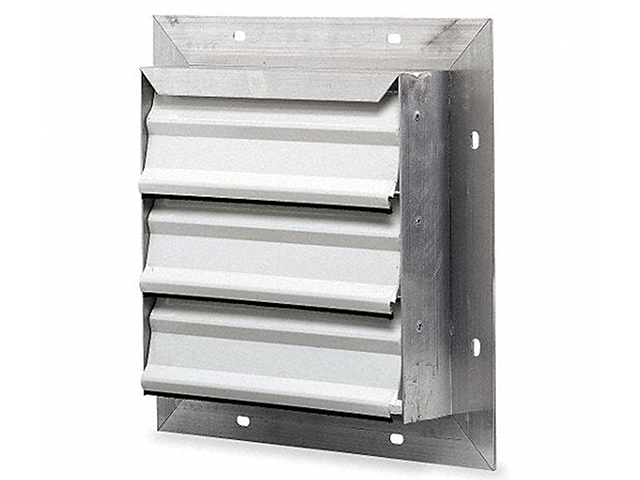
The Aluminum Shutter complements this system perfectly. It’s designed to work with the exhaust fan, pulling in air through durable aluminum louvers that open and close automatically with a motor, providing controlled and efficient airflow.
Find the Optimal Placement of Vents for Effective Air Movement
For the best airflow in your greenhouse, it’s all about where you put your vents. Roof vents should go along the top ridge, ensuring they can open all the way for the most air to get out. Side vents work best at the level of your benches so the fresh air hits your plants. You’ll want the total vent area to be at least 15-20% of your greenhouse’s floor space to get enough air moving in and out.
Set up your roof and side vents on opposite sides to promote a gentle cross breeze. Make sure nothing outside, like buildings or plants, blocks them. Monitor your vents to ensure they stay clear and work smoothly so your greenhouse always has fresh, circulating air.
Determine the Right Vent Size for Greenhouse Capacity
Figuring out the correct size for your greenhouse vents is vital to keep the air moving properly. You’ll want the total area of your vents to be around 15-20% of your greenhouse’s floor space. Start by calculating the square footage of your structure: multiply its length by its width.
So, if your greenhouse is 100 square feet, for example, you’re aiming for vents that add up to 15-20 square feet. Split this amount between your roof and side vents, with roof vents typically taking up about two-thirds of the total vent area to ensure good air exchange.
Your local weather matters, too. In places that are warmer or more humid, you might need even more vent space. Make sure your vents are spaced out well to keep the airflow even. And check that your vent setup still works well as you add new plants or switch up the types of plants you’re growing.
Modulate Air Movement with Adjustable Louvers
Fixed vents can’t adjust to changing weather, sometimes leading to too much airflow during harsh conditions or not enough when it’s really hot. Using adjustable shutters, panels, and louvers gives you more control over the air moving through your greenhouse.
With adjustable slats, you can avoid wind damage by directing gusts away from sensitive plants. At night, closing louvers can also keep heat in, improving insulation. Whether you choose manual options for quick changes or automated systems that adjust based on the weather, you have the flexibility to protect your plants better.
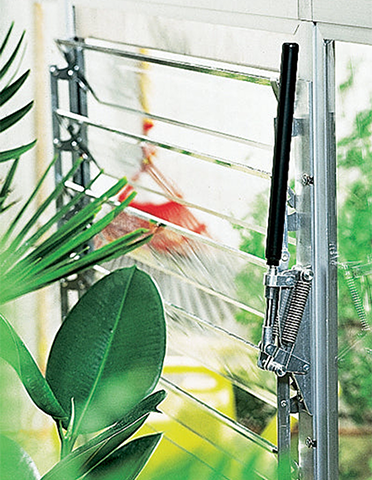
The Liberty Automatic Louver Opener offers a smart solution for greenhouse ventilation, using solar power to open and close louver windows automatically in response to temperature changes. You can set it to activate at temperatures ranging from 60°F to 77°F. Made from durable aluminum and stainless steel, it’s built to last, making it an efficient way to improve airflow in your greenhouse.
Enhance Cooling with Top Roof Vents
Greenhouses require different daytime cooling strategies than at night, and the location of your vents can help to manage internal temps at each point during the daily cycle.
In a greenhouse heated by the sun, warm air rises to the top, making it essential to have roof vents located at the highest interior point. These vents allow the hot air to escape before it can cool and descend to the plant level.
Positioning vents at the top helps cool the greenhouse without exposing the plants to cold drafts. Also, placing vents at the roof peak takes advantage of the natural upward movement of air, which can sometimes work better than using electric fans for ventilation.
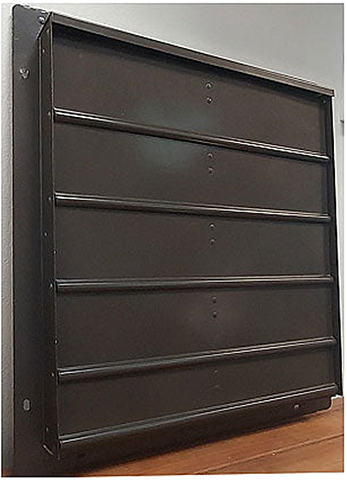
Bring fresh air into your greenhouse with Dayton’s 20" Wall Shutter/ Backdraft Damper/Wall Vent, perfect for passive ventilation. When used with an exhaust fan, it pulls air in efficiently. Made from lightweight galvanized aluminum, this shutter doesn’t need an electric motor, making it an economical choice for keeping air moving.
Maintain Warmth Through Vent Adjustment Techniques
Ceiling vents at the top let out warm air, while side vents closer to the ground pull in fresh air, creating a vital exchange that keeps both temperature and oxygen levels balanced. But, in the winter, too much ventilation can let out the heat you need to keep.
Close some side vents at night to contain interior warmth, and keep roof vents open to allow slight venting of rising warm air. This approach helps keep the air moving just enough to ward off mold without losing too much heat, especially around your plants.
Think about adding insulated shutters on your vents and automatic louvers that a thermostat controls to cut down on cold air coming in when it’s really chilly outside. This step is vital for growing tropical plants that need to stay warm all night long and during the colder parts of the year.
Adjust Ventilation According to Seasonal Changes
The ventilation needs of your greenhouse change with the seasons, as do the heating and cooling requirements. What works for keeping temperatures and humidity levels perfect in the summer could cause your plants to overheat in the spring and fall. Similarly, venting out hot air might be great for those really hot days but could lead to frost damage when it gets colder in the winter.
To keep the inside of your greenhouse just right, adjust how you ventilate and the settings on your vents as the seasons change. In the summer, you might open more roof vents and use additional fans to keep things cool. When winter rolls around, do the opposite to help trap warmth inside.
Benefit From Natural Air Movement
Before you turn on your automated ventilation system, think about using natural airflow as a way to save money. Simply opening up vents, doors, and windows to let the breeze flow through can provide effective passive ventilation at no cost. This natural method not only helps you cut down on expenses but also creates ideal growing conditions for your plants.
Letting the wind naturally circulate air removes stale air and replenishes CO₂, essential for photosynthesis, without needing to use any power.
Regular Monitoring and Upkeep for Maintaining Ventilation Efficiency
To ensure your greenhouse’s ventilation system keeps running smoothly, regularly inspect and upkeep parts such as vents, louvers, shutters, and fans. Doing so helps keep the system at peak performance and prevents sudden malfunctions.
Make sure to clear away any debris from intake guards, lubricate moving parts to prevent them from seizing up, and verify that actuators are fully opening and closing for precise automated control.
You’ll also need to recalibrate the sensors on your automated controllers annually to guarantee they’re providing accurate measurements. Having precise sensor information is essential for adjusting your equipment correctly.
Use Shade Screens and Curtains
Adding retractable shade screens and curtains to your greenhouse’s roof and walls offer an extra way to manage the climate inside. On extremely hot days, drawing the shades partially can shield your plants from harsh sunlight, helping to keep the interior cool. When it’s cold, thermal curtains can act as an insulation layer, trapping heat inside overnight.
These screens are available in both mesh and solid materials, each designed to filter light differently. Thick screens that block out more sunlight are perfect for cooling down your greenhouse in the summer, whereas lighter screens that let some light through can help lengthen the growing season during milder months.
If you have an automated curtain system linked to environmental controls, it can adjust the curtains automatically, opening or closing them based on the weather. This not only maintains optimal growing conditions but also protects your plants from harsh winds by closing when necessary.

The Lockknit Shade Fabric Kit offers a budget-friendly solution for greenhouse shading. This lightweight and easy-to-handle kit reduces temperatures up to 15°F, blocking infrared sun rays. With 18 grommet clips and a tie-down cord included, it’s reusable, easily customizable, and installs effortlessly for effective temperature control.
Achieve the Perfect Greenhouse Environment
Transform your greenhouse with ventilation solutions from Charley’s Garden & Greenhouse. Explore our range of greenhouse ventilation systems to find the perfect vents for your needs.
Don’t compromise on quality—choose Charley’s Garden & Greenhouse for precision, durability, and excellence in greenhouse ventilation equipment.

